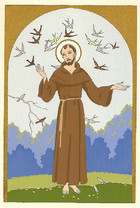Giovanni Meschini
(1888-1977)
Holy cards have been a staple of popular religious art ever since cheap woodcut images on sacred themes first appeared in 15th century Europe. Few makers of mass-market devotional art have created such works of beauty and refinement as Italian Graphic Artist Giovanni Meschini. At the peak of his career in the 1930s, Meschini designed dozens of hugely popular santini (holy cards) in his Ars Nova studio, first in Terni, Italy, and later in Rome, supervising their production by a skilled group of “colorists,” which painted every card by hand. Meschini often picked up a brush, himself, to help his team apply layers of color to paper through stencil cut-outs, a printmaking technique known as “pochoir,” from the French word for “stencil.”
The earliest examples of pochoir art date back at least a thousand years to China. The ancient art form underwent a dramatic revival in late 19th century Paris, when book publishers and haute couture fashion houses wanted a better way to mass produce color illustrations than was possible with existing mechanical methods. During the 1920s and 1930s, decorative artists like Italian Ex-Patriot Umberto Brunelleschi created pochoir images for the French market of ladies of fashion, oriental odalisques, and Venetian carnival revelers. These hand-painted prints defined the Art Deco style with their clean-edged, geometric forms and flat colors. When the fad for pochoir art waned in France, Meschini emerged in Italy as a new leader in the genre with his simple but elegant greeting cards, postcards, and santini, recalling the style of Brunelleschi.
Pochoir printmakers work from an original color image, deciding just how many different layers of colors are needed to recreate its palette and tone in reproduction. Holes are, then, cut for each color layer in thin metal or plastic stencil sheets. Carefully aligning the stencils on top of a piece of paper already printed with a black and white image or line-drawing, the pochoir artist dabs watercolor or gouache into the cut-out areas with a small, coarse-haired brush, called a pompon, making certain the paint does not seep into other parts of the protected paper underneath. It is a laborious process, involving, at least, 20 to 30 different color stencils and sometimes a 100 and even 250! The finished pochoir prints have a freshly painted look and a textured surface you can feel.
The Sacred Art Pilgrim Collection has 17 sacred art pochoir prints from Meschini’s Ars Nova studio in three formats: the “fine art” print, postcard, and prayer card. Meschini and his team of colorists not only changed the size of standardized designs but also varied background details and coloring, as can be seen in the two versions of santini in my collection of the Madonna, the Holy Family, St. Anthony & the Christ Child, and St. Francis of Assisi.
Sweet-faced Madonnas holding cherubic baby Christs dominate the Ars Nova religious product line. Jesus appears most often as the Good Shepherd and the Friend of Children. Only the Christus portrait reveals a more masterful, masculine Savior. This is not art to challenge but to comfort and console; its subject matter perfectly suited for First Communion cards.
The coming of World War II, changes in public taste, and improvements in cheaper mechanized reproduction processes like off-set printing spelled the end of the pochoir print. Once dismissed as kitsch art, the Ars Nova cards from Meschini have found new admirers in an age when computer-enhanced digital imaging can create art reproductions in such precise detail they are hard to distinguish from the originals. Meschini's elegantly simple sacred images remind us of a world we have lost, where beautiful objects for every day use were still made by hand.
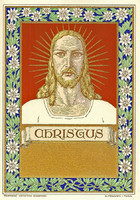
Christus
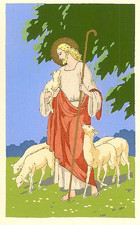
The Good Shepherd
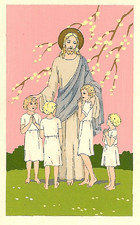
Jesus, the Friend of Children

Nativity

Madonna of the Lilies
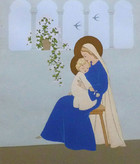
Madonna in Repose
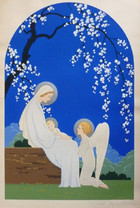
Madonna of the Flowering Tree
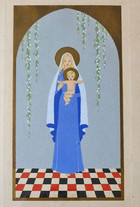
Madonna of the Checkered Floor
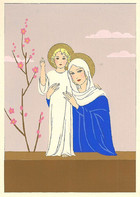
Madonna of the Almond Tree
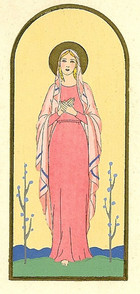
The Pink Madonna
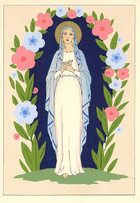
The Madonna in the Bower
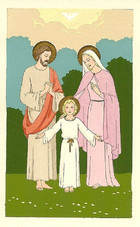
The Holy Family
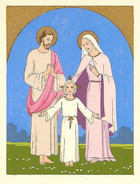
The Holy Family in Golden Arch
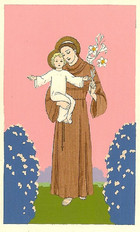
St. Anthony & the Christ Child
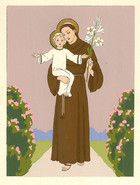
St. Anthony & Christ Child (Mauve)
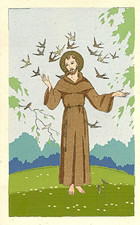
St. Francis
